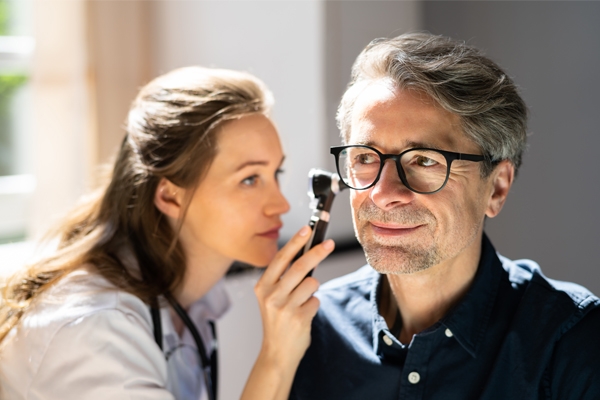Airplane Ear: Understanding, Avoiding, and Easing Discomfort

Airplane Ear: Understanding, Avoiding, and Easing Discomfort
10 min
Published July 8, 2025
Traveling by airplane has revolutionized the way we explore the world, but it's not without its challenges. One of these challenges is the discomfort known as "airplane ear", which can turn an exciting journey into a painful ordeal. In this article, we'll delve into what airplane ear is, and go over some common hearing problems associated with flying, as well as methods to prevent and alleviate them. We’ll also explain how airplane ear can lead to more serious complications.
What is Airplane Ear?
Airplane ear, also referred to as barotrauma or ear barotrauma¹, occurs when there is an air pressure imbalance between the middle ear and the atmosphere or air in the environment. The middle ear is the space behind the eardrum1 and contains the auditory ossicles (tiny bones in the ear - see our article on ossicles), which are vital for conducting sound waves to the inner ear. The Eustachian tube connects the middle ear to the back of the throat and helps equalize the pressure between the middle ear and the outside world.
During takeoff and landing, rapid changes in altitude cause the air pressure around us to vary. If the Eustachian tubes are unable to equalize this pressure quickly, a vacuum can form in the middle ear, pulling the eardrum inward and leading to discomfort. This is often felt as a sensation of fullness, ear popping5 or even pain².
General Ear Problems when Flying
Airplane ear is just one of the many ear or hearing problems travelers might encounter during a flight. Other common issues include²:
- Temporary Hearing Loss: Rapid pressure changes can also cause temporary hearing loss. Sounds may become muffled or distant due to the eardrum's inability to vibrate properly.
- Tinnitus: Some individuals experience a ringing, buzzing, or humming sound in their ears during or after a flight. This phenomenon, known as tinnitus, can be aggravated by pressure changes.
- Pain: The discomfort caused by pressure changes can sometimes escalate into sharp or dull pain in the ears.
- Vertigo: In some cases, the imbalance in pressure can disrupt the fluid balance in the inner ear, leading to a feeling of dizziness or vertigo.
How to Prevent Airplane Ear?
While airplane ear is a common occurrence, there are several strategies you can employ to minimize its impact:
- Swallowing and Yawning: Swallowing or yawning opens up the Eustachian tube, allowing air to flow in and out of the middle ear. Chewing gum or sucking on candy can help stimulate swallowing, while yawning naturally occurs when you're tired.
- Valsalva Maneuver: Pinch your nostrils shut, close your mouth, and gently exhale through your nose. This maneuver can help equalize pressure by forcing air into the Eustachian tube.
- Stay Hydrated: Drinking water helps keep the mucus in your Eustachian tubes thin, making it easier for the tubes to function properly.
- Avoid Sleep During Descent: While sleep can be tempting during a flight, try to stay awake during descent so you can actively manage pressure changes through swallowing and yawning.
How Long Does Airplane Ear Usually Last?
The discomfort of airplane ear typically subsides shortly after landing, once the pressure inside and outside the ear equalizes. In most cases, this discomfort is temporary and should go away within a few minutes to a few hours after the flight.
Can Airplane Ear Cause Ear Infection?
Airplane ear itself is not directly linked to ear infections. However, the changes in pressure and fluid balance can create an environment that might make you more susceptible to infections. If you experience symptoms like persistent pain, fever, or drainage from the ear, it's important to consult a healthcare professional, as these could be signs of an infection³,⁴.
Four Tips for Alleviating Airplane Ear
Aside from the prevention methods mentioned earlier, here are four additional tips to help you manage airplane ear:
- Use Earplugs: Some travelers find relief by using filtered earplugs designed to regulate pressure changes. These can be particularly helpful during takeoff and landing.
- Decongestants: Consult your healthcare provider before using decongestant nasal sprays or oral medications, as they can help keep your Eustachian tubes open by reducing congestion.
- Saline Nasal Spray: Spraying a saline solution in your nostrils can help keep the nasal passages moist and improve Eustachian tube function.
- Breathing Exercises: Practicing deep, slow breathing techniques can help relax your body and potentially aid in equalizing pressure.
Summary
Airplane ear is a discomfort many travelers experience during flights due to pressure changes. While it can be bothersome, there are numerous strategies to prevent or alleviate its effects. Remember to stay hydrated, swallow or yawn frequently, and consider using earplugs or decongestants if necessary. Most importantly, if you experience persistent pain or any unusual symptoms, seek medical attention to ensure a safe and pleasant travel experience.
Reference List
¹ National Library of Medicine - "Grand Strand Medical Ctr, University of Pennsylvania Philadelphia, , University Medical Center, LSU Medical School" (2023). Barotrauma. https://www.ncbi.nlm.nih.gov/books/NBK482348/
² Mayo Clinic. (2021). Airplane ear. https://www.mayoclinic.org/diseases-conditions/airplane-ear/symptoms-causes/syc-20351701
³ American Speech-Language-Hearing Association. (n.d.). Ear Infections (Otitis Media) https://www.asha.org/public/hearing/otitis-media/
⁴ American Academy of Otolaryngology-Head and Neck Surgery Ears and Altitude (Barotrauma) (2018) https://www.enthealth.org/conditions/ears-and-altitude-barotrauma/
⁵ Cleveland Clinic. (2022). How To Pop and Unclog Your Ears https://health.clevelandclinic.org/how-to-pop-your-ears




